New Zealand scientists record 'biodiversity breakdown'
- Published

An 18th century engraving of the Tui bird, one of New Zealand's native pollinating birds
Scientists in New Zealand say they have linked the modern-day decline of a common forest shrub with the local extinction of two pollinating birds over a century ago.
They say the disappearance of two birds - the bellbird and stitchbird - from the upper North Island of the country has lead to a slow decline in common plants, including the forest shrub New Zealand gloxinia.
Ship rats and stoats imported into the country around the year 1870 are blamed for the birds' demise.
The researchers claim the study, published in the journal Science, external, offers rare experimental proof of a breakdown in a local ecosystem.
Rats and stoats
New Zealand gloxinia or Rhabdothamnus solandri is a gangly forest shrub, which grows in the shade to about 2m high and produces an orange tubular flower. It depends on three birds for pollination - the bellbird, stitchbird and the tui.
While the latter now seems only to feed higher up in the forest canopy, the former two vanished from upper North Island in the late 19th century. It is thought they were killed off by rats brought in by ships or by stoats introduced to control the local rabbit population.
The researchers wanted to observe the impact on New Zealand gloxinia of these disappearing bird populations and so compared the situation on the mainland with that of three nearby island bird sanctuaries where the birds remain abundant.
What they found was that pollination rates were vastly reduced on the mainland with seed production per flower 84% lower compared with the islands.
While this has yet to fully manifest itself in the density of adult gloxinia populations on the mainland, the researchers found 55% fewer juvenile plants per adult plant on the mainland vis-à-vis the islands.

A shoot of New Zealand gloxinia, showing the bird-pollinated flower and its hairy leaves
The researchers could also quantify how often - or how little - birds visited the plant, as birds make distinct markings on the flower as they feed on the nectar.
"This plant is in trouble but it's a slow motion disaster," said Professor Dave Kelly of New Zealand's University of Canterbury, who led the research. "It hasn't been well pollinated for about the last 140 years - that's about when these birds disappeared off the North Island."
"In that time there haven't been enough seedlings coming through and so the plant is quietly crumbling away, fading away."
Mistletoe trick
It is not just gloxinia which is feeling the effects of these disappearing birds. An estimated 49% of all land birds have been lost in New Zealand, say the researchers, and the consequences of that are far greater than those outlined in this study.
A recent survey of all the country's bird-pollinated plants found only a fraction were pollinating normally. Species of mistletoe have been linked to the decline in bird species.
"Certain mistletoes have large red attractive flowers and they're quite widespread though the South Island and up into the lower North Island," says Dr Kelly.

The disappearance of the bellbird from parts of New Zealand's North Island, has taken its toll on flora
"The buds ripen and send a colour signal but they don't open up until a bird comes along and squeezes the top and if that doesn't happen the plant doesn't get pollinated. It turns out these native pollinating birds are pretty much the only birds that know the trick of opening these."
Professor Stephen Hopper, director of the Royal Botanic Gardens, Kew, said the work was an elegant piece of research which "highlights the cascading effects of extinction".
Nor was he surprised by the long lag between the disappearance of the birds and the effects on plantlife.
"You often see these lag effects in plants. In this case they're looking at woody plants and we know very little about their longevity," he told the BBC. "In some cases you may see big tress in the landscape and assume everything is going well when in fact they've stopped reproducing."
He says the events which can spark these ecological breakdowns are many, from the introduction of alien species such as in New Zealand, to land clearance to climate change.
- Published13 December 2010
- Published7 December 2010